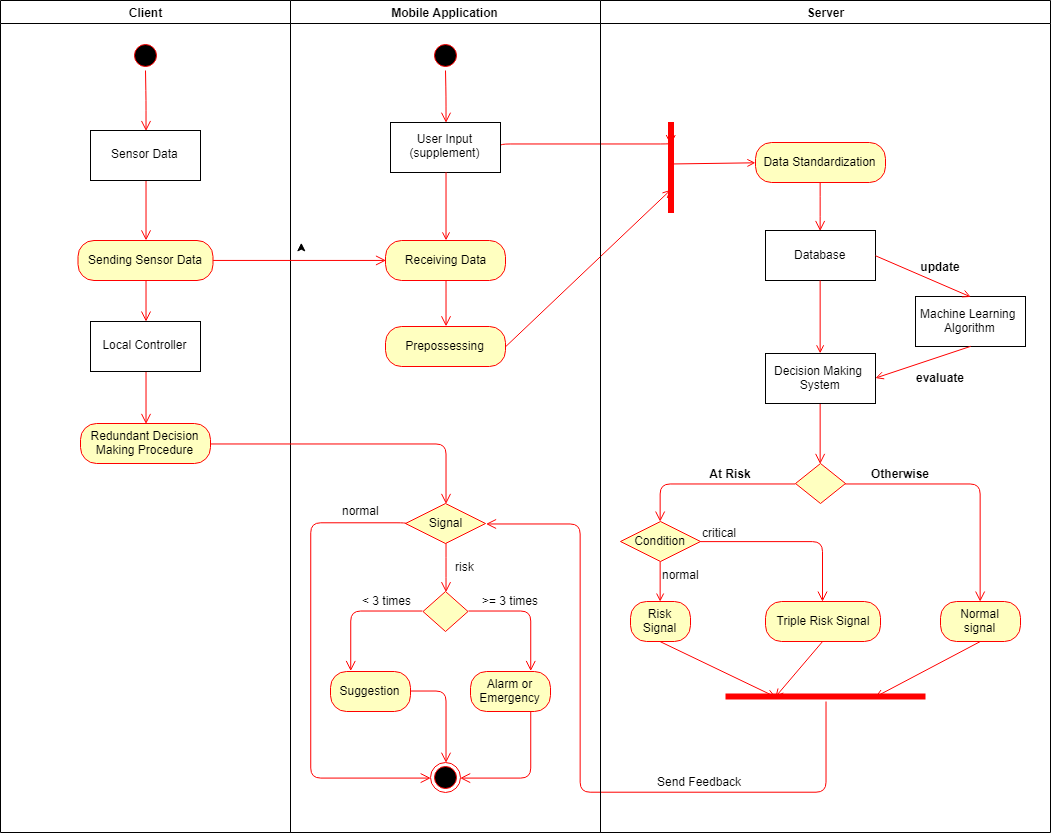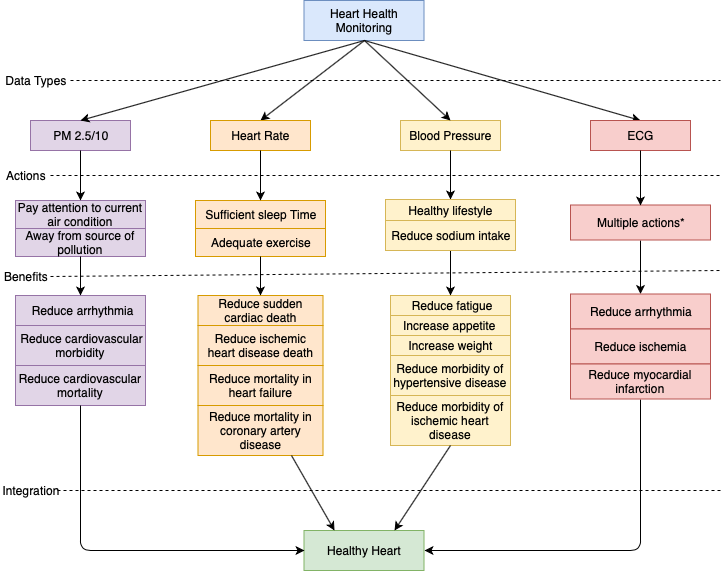Background
Heart disease has the highest mortality rate among all diseases in China and the prevalence is expected to deteriorate within the next decade [1]. Traditional health care system is supply-based and organized around providers (hospitals, medical practices, clinics, etc.). In most parts of the world population is aging and becoming less healthy due to consumerism, unhealthy diet, and sedentary life style. Health care costs are rapidly rising and there is a trend of moving health care services to patient homes as much as possible.
Motivation
New technology makes modern personal medical system possible; technology-enabled infrastructure that connects providers, caregivers and patients and links multiple sources of data. Simple collecting and connecting data is not sufficient, these data need to be coupled with medical knowledge and algorithms that help make timely and correct decisions about patient’s health needs. New technologies include sensor systems [2,3], wearables [2,4], personal health records [5], and the connectivity of devices through Internet of Things [6,7]. Although these technologies offer a great promise, to date no system has been shown to accurately collect data [8] and truly integrated systems do not exist yet. We propose to develop and implement a system for monitoring heart disease through integration of wearable devices, medical knowledge and relevant algorithms, and personal health record. This system takes input from continuous activity monitoring device (smart watch), smart devices that are used several times a day (smart scale, blood pressure monitor, breathing rate, blood sugar, and temperature). Similar systems have been proposed [9-12].
Objectives
This project focusses on applied computer science – we will use computer science techniques and methods to perform health monitoring (data collection, management and processing) and provide automated support for medical decision making through application of machine learning approaches [13]. The main aim of this project is to develop and implement a system for online analytics of heart disease monitoring data that can be used to predict various complications and rapidly advise patient about emerging risks. Our application will monitor several basic signs (weight, blood pressure, temperature, physical activity, heart rate, and sleep) and integrate these data into a decision-making system.
specific objectives are:
- Perform the survey of the state-of-the-art solutions for heart disease monitoring using sensor systems, personal health record, and wearables.
- Develop and implement a method for standardization of data streams for mobile monitoring of heart disease.
- Develop interface for data capture and analytics.
- Perform a demonstration example using weight gain related risks.
System Design




Project Plan
Software development will utilize Waterfall model of software development [14]. The waterfall model is suitable because this work will result in a working prototype and not a commercial product. The main priority of this project is functional software prototype that will effectively deal with analytics of highly dimensional noisy data. The theoretical technological and engineering aspects of the software development will be considered and deployed as a secondary priority in this project.
Project Schedule

Reference List
- Wei-Wei CH, Run-Lin GA, Li-Sheng LI, Man-Lu ZH, Wen WA, Yong-Jun WA, Zhao-Su WU, Hui-Jun LI, Dong-Feng GU, Yue-Jin YA, Zhe ZHENG LX. China cardiovascular diseases report 2015: a summary. Journal of geriatric cardiology: JGC. 2017 Jan;14(1):1.
- Tricoli A, Nasiri N, De S. Wearable and miniaturized sensor technologies for personalized and preventive medicine. Advanced Functional Materials. 2017 Apr;27(15):1605271.
- Andreu-Perez J, Poon CC, Merrifield RD, Wong ST, Yang GZ. Big data for health. IEEE J Biomed Health Inform. 2015 Jul 1;19(4):1193-208.
- Piwek L, Ellis DA, Andrews S, Joinson A. The rise of consumer health wearables: promises and barriers. PLoS Medicine. 2016 Feb 2;13(2): e1001953.
- Smith MI, Garcia G, Simon M, Bruchanski L, Frangella J, Sommer JA, Giussi MV, Luna DR. Lessons Learned After Redesigning a Personal Health Record. InMEDINFO 2017: Precision Healthcare Through Informatics: Proceedings of the 16th World Congress on Medical and Health Informatics 2018 Jan 31 (Vol. 245, p. 216). IOS Press.
- Al-Fuqaha A, Guizani M, Mohammadi M, Aledhari M, Ayyash M. Internet of things: A survey on enabling technologies, protocols, and applications. IEEE Communications Surveys & Tutorials. 2015 Jun 15;17(4):2347-76.
- Dimitrov DV. Medical internet of things and big data in healthcare. Healthcare informatics research. 2016 Jul 1;22(3):156-63.
- Rosenberger ME, Buman MP, Haskell WL, McConnell MV, Carstensen LL. 24 hours of sleep, sedentary behavior, and physical activity with nine wearable devices. Medicine and science in sports and exercise. 2016 Mar;48(3):457.
- Oresko JJ, Jin Z, Cheng J, Huang S, Sun Y, Duschl H, Cheng AC. A wearable smartphone-based platform for real-time cardiovascular disease detection via electrocardiogram processing. IEEE Transactions on Information Technology in Biomedicine. 2010 May;14(3):734-40.
- Watanabe H, Kawarasaki M, Sato A, Yoshida K. Development of wearable heart disease monitoring and alerting system associated with smartphone. Ine-Health Networking, Applications and Services (Healthcom), 2012 IEEE 14th International Conference on 2012 Oct 10 (pp. 292-297). IEEE.
- Baig MM, Gholamhosseini H. Smart health monitoring systems: an overview of design and modeling. Journal of medical systems. 2013 Apr 1;37(2):9898.
- Kakria P, Tripathi NK, Kitipawang P. A real-time health monitoring system for remote cardiac patients using smartphone and wearable sensors. International journal of telemedicine and applications. 2015 Jan 1; 2015:8.
- Chen JH, Asch SM. Machine learning and prediction in medicine—beyond the peak of inflated expectations. The New England journal of medicine. 2017 Jun 29;376(26):2507.
- Petersen K, Wohlin C, Baca D. The waterfall model in large-scale development. In International Conference on Product-Focused Software Process Improvement 2009 Jun 15 (pp. 386-400). Springer, Berlin, Heidelberg.